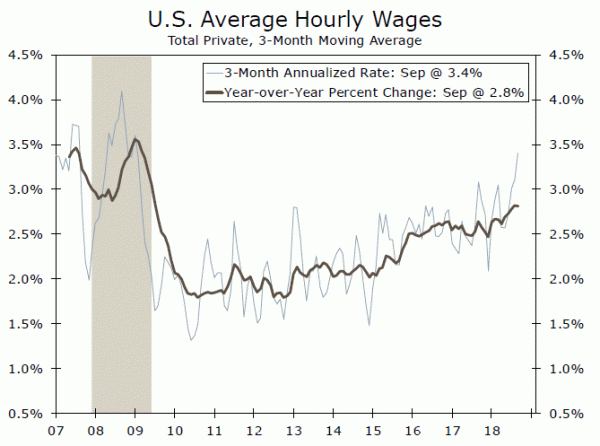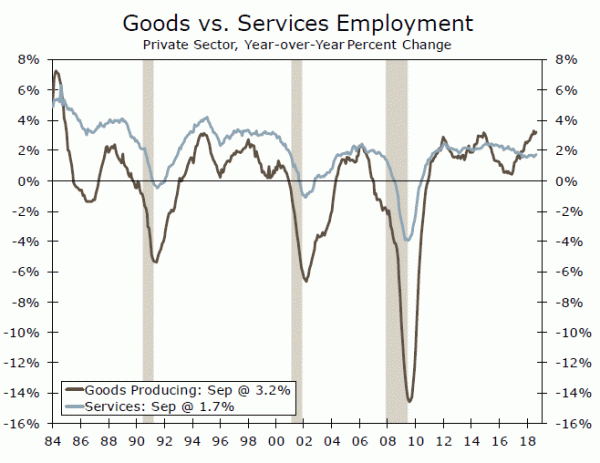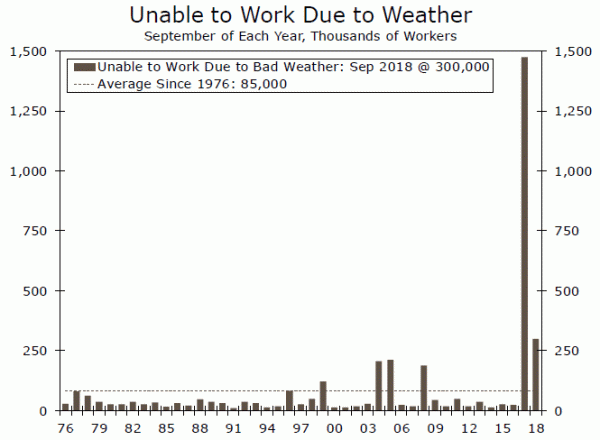Payroll growth slowed to 134,000 in September, likely depressed in part by Hurricane Florence. Other labor market indicators, including a decline in unemployment and rising earnings, show no signs of cooling.
Payrolls Look to Have Slowed—For Now
Payroll growth disappointed in September with employers adding 134,000 jobs. That was likely depressed by Hurricane Florence hitting the Carolinas during the survey reference period. Relative to last year’s storms, Florence hit a less populated area and also came at the tail end of the survey week, which meant many workers in its path were still able to clock in for part of the week and be counted as employed. Nevertheless, about 300,000 workers said they were unable to work due to bad weather, compared to an average of 85,000 workers in a typical September.
It is worth noting that September is a month where the initial estimate of payroll growth tends to be revised upward. Over the course of the expansion, revisions have brought September payroll growth up by about an average of 55,000. Therefore, between the storm and typical revisions, we do not think the trend in payroll growth has slowed to the extent stated by today’s report. Revisions to recent months’ data offer some support to this view. Payroll growth for July and August was revised up by 87,000. While that brought the three-month average down to a gain of 190,000, that is a bit better than the three-month pace initially reported in August (185,000).
By industry, the goods-sector continues to expand at a torrid pace, with sizeable gains in manufacturing, construction and mining last month. Services were the soft spot, with the retail and leisure & hospitality industries cutting employment in September.
With much of the slowdown in hiring coming from the heavily part-time and lower-paying retail and leisure & hospitality industries, the average workweek was left unchanged and average hourly earnings posted another solid gain (0.3%). That followed a 0.3% gain in earnings in August and pushed the three-month annualized rate to 3.8%. It would not be surprising to see that cool off a bit the next few months given this month’s industryrelated boost and favorable calendar dynamics that BLS adjustments do not fully seem to capture (timing of survey week, workweek days in the month).
Payroll Slowdown Not Corroborated by Other Measures
Other employment data do not give any sign of the labor market weakening, let alone to the extent of September’s payrolls. Job openings and the share of businesses reporting they have at least one position that is hard to fill sit at record highs, as does the hiring index in the ISM non-manufacturing survey. At the same time, the near 50-year low in initial jobless claims points to firms hanging on to workers, given the difficulty to re-hire later on.
The decline in the unemployment rate to 3.7% and upward march in wage growth will keep the FOMC pressing ahead with rate hikes. We continue to look for the FOMC to raise rates more than the market currently expects over the next 12 months and for the committee to target a fed funds rate of 3-3.25% by the end of Q3-2019.















